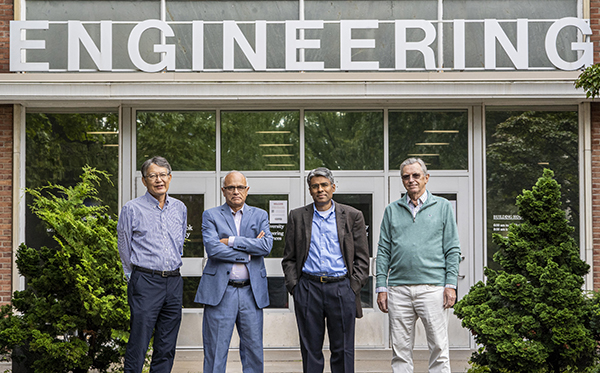
About 2.5 million miles of pipelines transport natural gas, accounting for about 25 percent of all the energy consumed in the U.S. each year. If the fossil-based natural gas is replaced with a greener substitute such as hydrogen, there is an increased opportunity to deliver a transformative impact in the clean energy space.
A team of researchers in Stony Brook’s Department of Materials Science and Chemical Engineering, led by professor T.A. Venkatesh, has been awarded $1.8 million from the National Science Foundation’s (NSF) Designing Materials to Revolutionize and Engineer our Future (DMREF) program. The award will advance our hydrogen knowledge frontier and help enable a marketplace for a clean hydrogen economy. Stony Brook will lead the project in partnership with Stanford University, MIT and Sandia National Lab, in addition to industry partners National Grid and Exxon Mobil.
“The benefits of hydrogen are compelling,” said Venkatesh, associate professor in the Department of Materials Science and Chemical Engineering. “It is a highly flexible energy carrier and has the potential to store more dispersed renewable energy, at a lower cost, and complement traditional energy storage methods such as electrochemical batteries, particularly at grid-scale.”
This energy has the potential to generate electricity with fuel cells, power fuel cell hybrid electric vehicles and serve as a clean fuel source for turbines to address peak power demands. Hydrogen can also be blended with pipeline natural gas to make the gas distribution networks a potential asset to facilitate the transport and storage of large amounts of renewable power which can be used to heat or cool buildings.
With the focus on developing a computationally driven multi-scale modeling platform, this project will accelerate discovery of controlling mechanisms of hydrogen embrittlement and associated lower fracture toughness to enable quicker development of hydrogen-resistant materials. This is particularly ideal for the energy transportation sector as it transitions from the transport of fossil fuels to hydrogen-based renewables. The research aims to lead to the development of reliable engineering roadmaps for life prediction and risk assessment for hydrogen storage and transport structures.
“Venkatesh and his team are developing highly relevant hydrogen-resistant materials for storage and transport applications that have the potential to help create a robust, new hydrogen economy that can transform the fabric of our infrastructure,” said Jon Longtin, interim dean of the College of Engineering and Applied Sciences. “This collaboration will make a real impact toward exploring new materials and applications for clean energy alternatives.”
Stony Brook’s Institute of Gas Innovation and Technology (I-GIT) is engaged to develop close connections with several key industry partners that include National Grid, to form a vertically integrated partnership that can deliver value, at scale, from production and storage to transportation and end use of hydrogen in the northeastern U.S.
“At I-GIT, several projects are underway to collect data under high to low pressure pipeline mimic conditions that would help decarbonize power and transport sectors,” said Devinder Mahajan, director of the I-GIT and professor and graduate program director in the Department of Materials Science and Chemical Engineering. “The NSF funded project will complement these ongoing activities.”
“This program of research will, in part, facilitate a better understanding of the atomistic interactions of hydrogen with a variety of steels, that may be relevant to the ultimate durability of transcontinental gas pipe-lines to conjoint attack by aqueous corrosion and cyclic stress,” said Clive Clayton, leading professor in the Department of Materials Science and Chemical Engineering.
Computational efforts will build upon the recent advances made in atomistic simulations (at Sandia National Laboratory/Stanford), dislocation dynamics simulations (at Stanford), with insights on crystal plasticity (from MIT) and continuum level modeling for stress and fracture analyses (from Stony Brook). The experimental efforts will leverage improved and unique capabilities that include Nanoindentation (at MIT/Stony Brook), X-Ray Tomography (at Brookhaven National Laboratory), and in situ testing in hydrogen environment (at Sandia National Laboratory).
“Beyond the field of hydrogen storage and transport, the fundamental insights obtained from this project would also help in designing fatigue and corrosion resistant sub-surface steel structures with longer lifetimes, making off-shore wind more cost effective as well,” said Venkatesh.
Venkatesh, who leads the Smart Materials and Nanotechnology Research Group, is the team’s principal investigator. Co-principal investigators are Mahajan; Clayton, a Fellow of the Electrochemical Society and past chair of the Corrosion Division; and Toshio Nakamura, professor in the Department of Mechanical Engineering and director of the Computational Solid Mechanics Laboratory.
Read the most up to date Fuel Cell and Hydrogen Industry news at FuelCellsWorks




